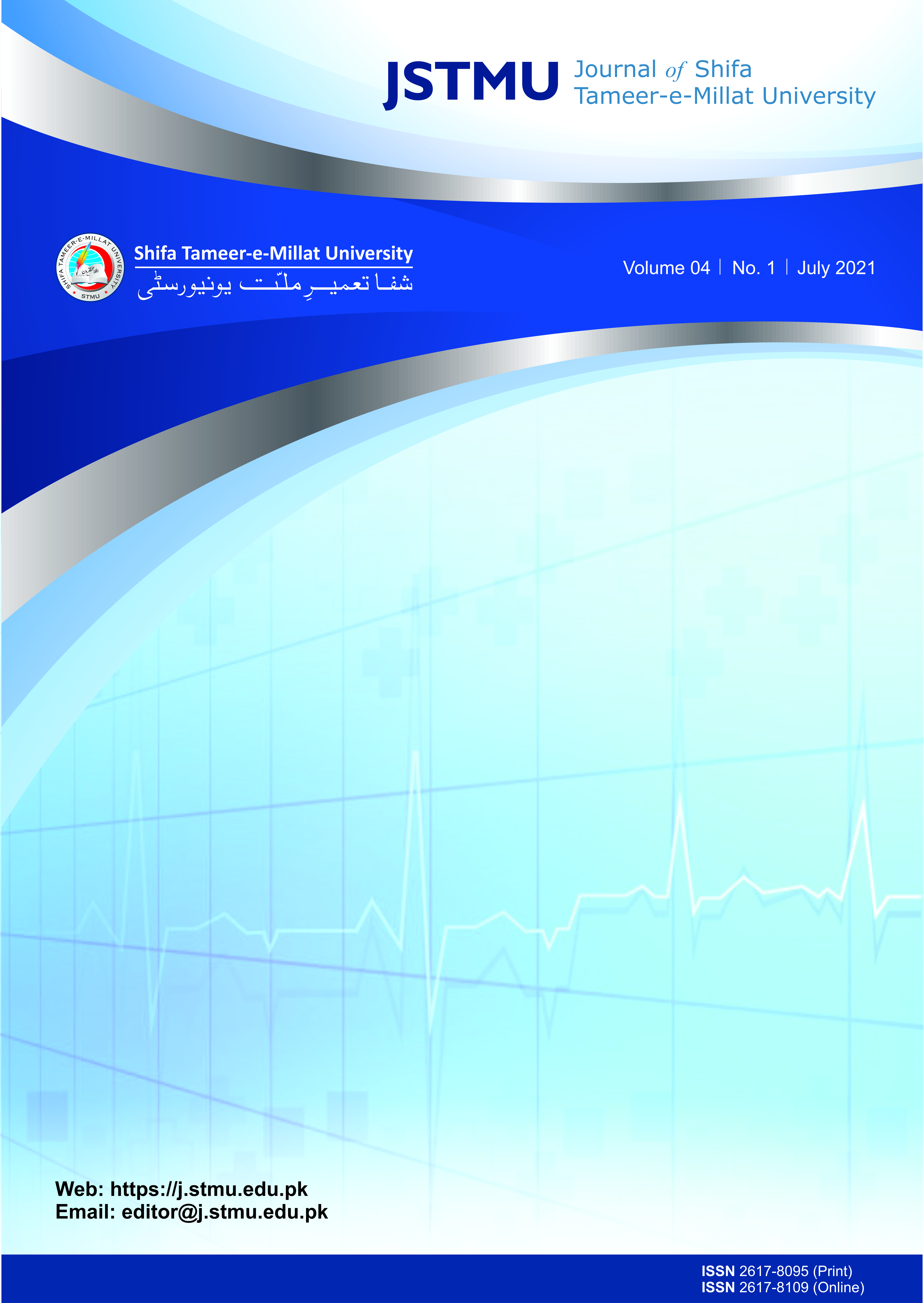Effects of Surah Al-Rehman on pain, oxygen-saturation, and vital signs in post CABG patients: A Pilot Study
Abstract
Objective: The main objective of the study was to determine the effects of Surah Al-Rehman on post CABG patients’ pain level, oxygen saturation, and vital signs.
Methodology: A quasi-experimental pre and post-test design was used with a sample size of 60 patients in two tertiary care Hospitals, from July 2018 to September 2018. A non-probability convenient sampling method was used to recruit the participants. Post CABG adult Muslim patients were the study participants. Surah Al-Rehman’s recitation in the voice of the Qari Abdul Basit was the intervention for the current study. At a significance level of p-value ≤ 0.05, a repeated measure ANOVA was applied to determine the effects of Surah Al-Rehman on the outcome variables, which were patient’s pain level, oxygen saturation level, and vital signs including heart rate [HR], respiratory rate [RR], systolic and diastolic blood pressure.
Results: Overall, Surah Al Rehman had shown statistically significant effects on the participants’ pain level (p<0.001), oxygen saturation level (p=0.01), respiratory rate (p<0.001), and diastole blood pressure (DBP, p=0.04). A minimum change in the pre and post values of HR and systolic blood pressure (SBP) was also observed, but statistically, this change was insignificant (HR, p=0.13 & SBP, p=0.47).
Conclusion: Findings of the current study demonstrated that listening to the recitation of Surah Al-Rehman could decrease pain level, RR, DBP and enhance oxygen-saturation in post CABG patients.
Downloads
References
Chai Q, Liu J. Early stage effect of ischemic preconditioning for patients undergoing on-pump coronary artery bypass grafts surgery: systematic review and meta-analysis. Pak J Med Sci. 2014 ;30(3):642.
DOI: https://doi.org/10.12669/pjms.303.4292
Leegaard M, Watt-Watson J, McGillion M, Costello J, Elgie-Watson J, Partridge K. Nurses' educational needs for pain management of post-cardiac surgery patients: a qualitative study. J cardior Nur. 2011; 26(4):312-20.
DOI: https://doi.org/10.1097/JCN.0b013e3181f806bc
Hosain N, Amin F, Rehman S, Koirala B. Know thy neighbors: The status of cardiac surgery in the South Asian countries around India. Indian Heart J. 2017; 69(6):790-6.
DOI: https://doi.org/10.1016/j.ihj.2017.09.219
Ajorpaz NM, Mohammadi A, Najaran H, Khazaei S. Effect of music on postoperative pain in patients under open heart surgery. Nursing and midwifery studies. 2014; 3(3).
Apfelbaum JL, Chen C, Mehta SS, Gan TJ. Postoperative pain experience: results from a national survey suggest postoperative pain continues to be undermanaged. Anesthesia & Analgesia. 2003; 97(2):534-40.
DOI: https://doi.org/10.1213/01.ANE.0000068822.10113.9E
Liu Y, Petrini MA. Effects of music therapy on pain, anxiety, and vital signs in patients after thoracic surgery. Complementary Therap Med. 2015; 23(5):714-8.
DOI: https://doi.org/10.1016/j.ctim.2015.08.002
Rafique R, Anjum A, Raheem SS. Efficacy of Surah Al-Rehman in Managing Depression in Muslim Women. J Relign Health. 2019; 58(2):516-26.
DOI: https://doi.org/10.1007/s10943-017-0492-z
Mansouri A, Vahed AS, Sabouri AR, Lakzaei H, Arbabisarjou A. Investigating aid effect of Holy Quran sound on blood pressure, pulse, respiration and O2 Sat in ICU Patients. Int J Sci Study. 2017;5(7):218-22.
DOI: https://doi.org/10.17354/ijssI/2017/1
Mirzaeian R, Shirvani M, Alidosti M, Heydarabadi B. The Effect of Holy Quran Recitation Sound on Vital Signs and Arterial Oxygen Pressure of Unconscious Patients Hospitalized in Icu. Indo American J Pharmac Sci. 2017; 4(5):1254-9.
Rafiei H. Effect of Listening to Preferred Music on Intensity of Pain and Physiologic Parameters in Patients Undergoing Coronary Artery Bypass Grafting Surgery. IOSR J Nur Health Sci. 2016.
DOI: https://doi.org/10.9790/1959-0504027982
MirbagherAjorpaz N, Aghajani M. The effects of music and Holy Quran on patients' anxiety and vital signs before Abdominal surgery. Evidence Based Care. 2011;1(1):63-76.
DOI: https://doi.org/10.22038/EBCJ.2011.3765
Awa SB. Effects of holy quran listening on physiological stress response among muslim patients in intensive care unit. InE-proceedings Conf. Manag. Muamalah, no. May 2014 May (pp. 978-983).
Whitehead AL, Julious SA, Cooper CL, Campbell MJ. Estimating the sample size for a pilot randomised trial to minimise the overall trial sample size for the external pilot and main trial for a continuous outcome variable. Statist Method Med Res. 2016; 25(3):1057-73.
DOI: https://doi.org/10.1177/0962280215588241
Mirsane, S. A., Ajorpaz, N. M., Shafagh, S., &Aminpour, J. The Effect of Video and Images of Operating Room on Patients’ Anxiety before General Surgery: A Randomized Clinical Trial. J Critic Care Nur. 2016; 9(2)
DOI: https://doi.org/10.17795/ccn-6543
Beiranvand S, Noparast M, Eslamizade N, Saeedikia S. The effects of religion and spirituality on postoperative pain, hemodynamic functioning and anxiety after cesarean section. Acta MedicaIranica. 2014; 52(12):909-15.
Farzin AF, Zare M, Mousavi GS, Behnam VH, Talebi S. Comparative Study of the Effect of Allah’s Recitation and Rhythmic Breathing on Postoperative Pain in Orthopedic Patients 2018:68-78.
Nasiri M, Fayazi S, Ghaderi M, Naseri M, Adarvishi S. The Effect of Reciting the Word “Allah” on Pain Severity After Coronary Artery Bypass Graft Surgery: A Randomized Clinical Trial Study in Iran. Anesthesiol Pain Med. 2014; 4(5).
DOI: https://doi.org/10.5812/aapm.23149
Lahtinen P, Kokki H, Hynynen M. Pain after Cardiac Surgery A Prospective Cohort Study of 1-Year Incidence and Intensity. Anesthesiology: J Am Soc Anesthesiolo. 2006; 105(4):794-800.
DOI: https://doi.org/10.1097/00000542-200610000-00026.
Polit, D. F., Beck, C. T., &Polit, D. F. (2018). Resource Manual for Nursing Research: Generating and Assessing Evidence for Nursing practice. Philadelphia: Wolters Kluwer Health/Lippinocott Williams & Wilkins.
Copyright (c) 2021 Journal of Shifa Tameer-e-Millat University

This work is licensed under a Creative Commons Attribution-NonCommercial-ShareAlike 4.0 International License.
Journal of Shifa Tameer-e-Millat University (JSTMU) is the owner of all copyright to any work published in the journal. Any material printed in JSTMU may not be reproduced without the permission of the editors or publisher. The Journal accepts only original material for publication with the understanding that except for abstracts, no part of the data has been published or will be submitted for publication elsewhere before appearing and/or decision in this journal. The Editorial Board makes every effort to ensure the accuracy and authenticity of material printed in the journal. However, conclusions and statements expressed are views of the authors and do not necessarily reflect the opinions of the Editorial Board or JSTMU.

Content of this journal is licensed under a Creative Commons Attribution-NonCommercial-ShareAlike 4.0 International License.



